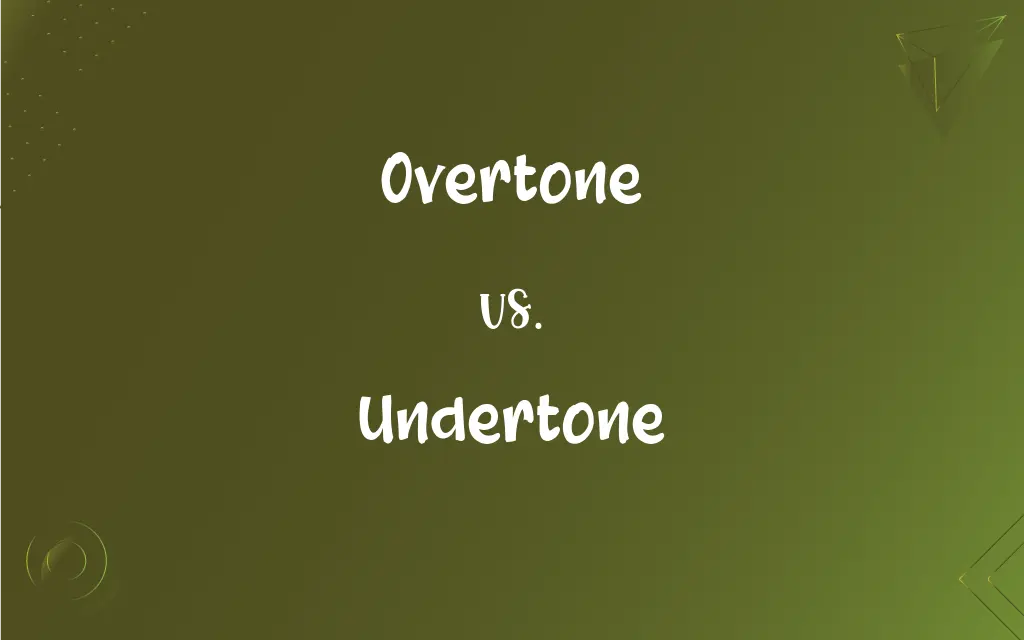Overtone vs. Undertone: What's the Difference?
By Aimie Carlson || Updated on May 30, 2024
Overtone refers to the higher frequencies accompanying a fundamental tone, shaping timbre; undertone suggests a subtle or underlying quality, often with hidden implications.

Key Differences
Overtone refers to higher frequency sound waves that resonate along with the fundamental tone. These contribute to the richness and color of the sound, enhancing musical instruments' timbre. In contrast, undertone indicates a subtle or underlying element in speech or text, often suggesting a hidden or secondary meaning.
Overtones are critical in music, as they determine the unique sound quality of different instruments, even when playing the same note. For instance, a piano and a violin sound distinct due to their overtones. On the other hand, undertones in communication imply nuances and subtleties that convey deeper emotions or sentiments without being explicitly stated.
In acoustics, overtones are harmonics that are integer multiples of the fundamental frequency, enriching the auditory experience. Conversely, in literature or speech, undertones provide depth by hinting at additional meanings or feelings, enriching the narrative or dialogue.
Overtones can be intentionally manipulated by musicians to achieve desired sound effects, whereas undertones can be either intentionally or unintentionally included in communication, influencing how messages are perceived and interpreted.
Comparison Chart
Definition
Higher frequencies accompanying a fundamental tone
Subtle or underlying quality or implication
ADVERTISEMENT
Field
Acoustics and music
Literature, speech, and communication
Purpose
Enhances timbre and sound quality
Adds depth and hidden meanings
Example
A violin's distinct sound from its overtones
A sarcastic remark with an undertone of anger
Manipulation
Intentionally controlled by musicians
Can be intentional or unintentional by speakers
Overtone and Undertone Definitions
Overtone
Acoustic elements that define the character of a note.
The overtones make the cello's lower notes particularly warm.
ADVERTISEMENT
Undertone
Nuance that adds depth to dialogue or text.
The story's happy ending had an undertone of melancholy.
Overtone
Higher frequency sound waves accompanying a fundamental tone.
The violin's overtones create a rich and vibrant sound.
Undertone
Subtle or underlying quality in speech or writing.
His compliment had an undertone of sarcasm.
Overtone
Harmonics that enhance the timbre of musical instruments.
The piano's overtones distinguish it from other instruments.
Undertone
Implied sentiment that is not explicitly stated.
The politician's speech had an undertone of urgency.
Overtone
Frequencies that resonate alongside the primary note.
Overtones give the trumpet its bright and clear sound.
Undertone
An underlying or implied tendency or meaning; an undercurrent.
Overtone
An ulterior, usually implicit meaning or quality; an implication or a hint
An overtone of anger barely masked.
Praise with overtones of envy.
Undertone
A tone of low pitch or volume, especially of spoken sound.
Overtone
See harmonic.
Undertone
A pale or subdued color.
Overtone
A tone whose frequency is an integer multiple of another; a member of the harmonic series.
Undertone
A color applied under or seen through another color.
Overtone
An implicit message (in a film, book, verbal discussion or similar) perceived as overwhelming the explicit message.
Undertone
An auditory tone of low pitch or volume.
Overtone
(transitive) To give an overtone to.
Undertone
An implicit message perceived subtly alongside, but not detracting noticeably from, the explicit message conveyed in or by a book, film, verbal dialogue or similar (contrast with overtone); an undercurrent.
Overtone
One of the harmonics faintly heard with and at a higher frequency than a fundamental tone as it dies away, produced by some aliquot portion of the vibrating sting or column of air which yields the fundamental tone; one of the natural harmonic scale of tones, as the octave, twelfth, fifteenth, etc.; an aliquot or "partial" tone; a harmonic. See Harmonic, and Tone.
Undertone
A pale colour, or one seen underneath another colour.
Overtone
(usually plural) an ulterior implicit meaning or quality;
Overtones of despair
Undertone
A low state of the physical faculties.
Overtone
A harmonic with a frequency that is a multiple of the fundamental frequency
Undertone
To accompany as an undertone.
Overtone
Secondary sounds that contribute to musical texture.
The guitar's overtones are more pronounced in an acoustic setting.
Undertone
To say or speak in an undertone.
Undertone
To present as less important, noticeable or prominent.
Undertone
A low or subdued tone or utterance; a tone less loud than usual.
Undertone
A quiet or hushed tone of voice;
Spoke in undertones
Undertone
Subdued emotional quality underlying an utterance; implicit meaning
Undertone
A pale or subdued color
Undertone
Hidden or secondary meaning in communication.
The letter carried an undertone of regret.
Undertone
Background emotion or mood hinted at indirectly.
There was an undertone of tension in their conversation.
FAQs
Can overtones be controlled by musicians?
Yes, musicians can manipulate overtones to achieve desired sound effects and enhance musical expression.
How do overtones affect musical instruments?
Overtones contribute to the unique sound quality of each instrument, making them sound distinct even when playing the same note.
What is an overtone in music?
An overtone is a higher frequency sound wave that accompanies the fundamental tone, enhancing the timbre of the sound.
Are undertones always intentional?
Undertones can be both intentional and unintentional, depending on the context and the speaker's or writer's intent.
What is the significance of undertones in literature?
In literature, undertones provide additional layers of meaning, enhancing the depth and complexity of the narrative.
Do all musical instruments produce overtones?
Yes, all musical instruments produce overtones, which contribute to their unique sound qualities.
What role do overtones play in acoustics?
Overtones, as harmonics, enrich the auditory experience by adding complexity and richness to sounds.
What is the difference between overtones and undertones in terms of perception?
Overtones are directly heard and contribute to the sound's timbre, whereas undertones are subtly perceived and suggest hidden meanings.
How do undertones influence interpretation?
Undertones add depth and nuance to communication, influencing how messages are perceived and interpreted by the audience.
Can undertones change the tone of a conversation?
Yes, undertones can significantly alter the perceived tone and emotional impact of a conversation.
What is an undertone in communication?
An undertone is a subtle or underlying quality or implication in speech or writing, often suggesting hidden meanings or sentiments.
How do overtones relate to harmonics?
Overtones are a type of harmonic, specifically the higher frequencies that resonate alongside the fundamental frequency.
What creates overtones in a sound wave?
Overtones are created by the vibration of the instrument or vocal cords at multiple frequencies.
Are undertones present in visual art as well?
Yes, undertones can be present in visual art, where they suggest underlying themes or emotions.
What is the primary purpose of overtones in music?
The primary purpose of overtones is to enhance the richness and complexity of musical sounds.
Can overtones be heard separately from the fundamental tone?
Overtones are typically heard as part of the overall sound rather than separately, contributing to the character of the tone.
How do writers use undertones effectively?
Writers use undertones to add depth, suggest subtext, and convey emotions or themes indirectly.
What is an example of an undertone in a speech?
An example of an undertone in a speech could be a seemingly positive statement with an underlying hint of criticism.
Can overtones be visualized?
Yes, overtones can be visualized using spectral analysis, showing the different frequencies present in a sound.
How do overtones and undertones differ in their usage?
Overtones are used in the context of sound and music to describe harmonics, while undertones are used in communication and art to describe hidden or subtle meanings.
About Author
Written by
Aimie CarlsonAimie Carlson, holding a master's degree in English literature, is a fervent English language enthusiast. She lends her writing talents to Difference Wiki, a prominent website that specializes in comparisons, offering readers insightful analyses that both captivate and inform.































































